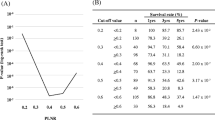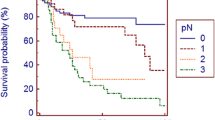Abstract
Background
The aim of this study was to evaluate the prognostic value of the ratio of metastatic to examined lymph nodes (N ratio) in gastric cancer patients who underwent limited lymphadenectomy and had a small number (≤15) of analyzed nodes.
Methods
The prognostic value of the actual AJCC/UICC pN staging system and the N ratio (0%, 1–25%, > 25%) were analyzed by means of univariate and multivariate analyses for 526 patients who underwent R0 resection for gastric adenocarcinoma at the Latvia Oncology Center.
Results
The mean (SD) number of analyzed nodes was 5.6 (2.8). The number of positive nodes significantly increased with the number of analyzed nodes (p < 0.001). No significant differences in survival (p = 0.508) and risk of death (p = 0.224) were observed between pN1 and pN2 subsets. When the N ratio (1–25% vs. > 25%) was taken into account, a significant difference was demonstrated between pNR1 and pNR2 with respect to survival (p = 0.017) and risk of death (p = 0.012). Nonetheless, the joint allocation of the two classifications demonstrated that only a minority of patients (28 cases) belonged to the pNR1 subset and none of these belonged to the AJCC/UICC pN2 subset.
Conclusions
When a small number of lymph nodes are analyzed, the N ratio can discriminate patients better than TNM classification. However, because a small number of retrieved nodes produced only a small number of pNR1 patients, the N ratio classification cannot be justified for clinical use.



Similar content being viewed by others
References
Siewert JR, Böttcher K, Stein HJ et al (1998) Relevant prognostic factors in gastric cancer. Ten-year results of the German Gastric Cancer Study. Ann Surg 228:449–461
Fujii K, Isozaki K, Okajima K et al (1999) Clinical evaluation of lymph node metastasis in gastric cancer defined by the fifth edition of the TNM classification in comparison with the Japanese system. Br J Surg 86:685–689
Katai H, Yoshimura K, Maruyama K et al (2000) Evaluation of the new International Union Against Cancer TNM staging for gastric carcinoma. Cancer 88:1796–1800
de Manzoni G, Verlato G, Roviello F et al (2002) The new TNM classification of lymph node metastasis minimises stage migration problems in gastric cancer patients. Br J Cancer 87:171–174
Bando E, Yonemura Y, Taniguchi K et al (2002) Outcome of ratio of lymph node metastasis in gastric carcinoma. Ann Surg Oncol 9:775–784
Shen JY, Kim S, Cheong JH et al (2007) The impact of total retrieved lymph nodes on staging and survival of patients with pT3 gastric cancer. Cancer 110:745–751
de Manzoni G, Verlato G, Guglielmi A et al (1999) Classification of lymph nodes metastases in the carcinoma of the stomach: comparison between the old and the new TNM systems. World J Surg 23:664–669
Ichikura T, Tomimatsu S, Uefuji K et al (1999) Evaluation of the new American Joint Committee on Cancer/International Union Against Cancer classification of lymph node metastasis from gastric cancer carcinoma in comparison with the Japanese classification. Cancer 86:553–558
Feinstein AR, Sosin DM, Wells CK (1985) The Will Rogers phenomenon. Stage migration and new diagnostic techniques as a source of misleading statistics for survival in cancer. N Engl J Med 312:1604–1608
Bunt AM, Hermans J, Smith VT et al (1995) Surgical/pathologic-stage migration confounds comparisons of gastric cancer survival rates between Japan and Western countries. J Clin Oncol 13:19–25
Marchet A, Mocellin S, Ambrosi A, Morgagni P (2007) The ratio between metastatic and examined lymph nodes (N Ratio) is an independent prognostic factor in gastric cancer regardless of the type of lymphadenectomy. Results from an Italian multicentric study in 1853 patients. Ann Surg 245:543–552
Hyung WJ, Noh SH, Yoo CH et al (2002) Prognostic significance of metastatic lymph node ratio in T3 gastric cancer. World J Surg 26:323–329
Celen O, Yildirim E, Berberoglu U (2007) Prognostic impact of positive lymph node ratio in gastric carcinoma. J Surg Oncol 96:95–101
Xu D, Geng Q, Long Z et al (2009) Positive lymph node ratio is an independent prognostic factor in gastric cancer after D2 resection regardless of the examined number of lymph nodes. Ann Surg Oncol 16:319–326
Sun Z, Zhu GL, Lu C et al (2009) The impact of N-ratio in minimizing stage migration phenomenon in gastric cancer patients with insufficient number or level of lymph node retrieved: results from a Chinese mono-institutional study in 2159 patients. Ann Oncol 20:897–905
Sivins A, Pedrazzani C, Roviello F et al (2009) Surgical treatment of gastric cancer in Latvia. Results of centralized experience. Eur J Surg Oncol 35:481–485
Macdonald JS, Smalley SR, Benedetti J et al (2001) Chemoradiotherapy after surgery compared with surgery alone for adenocarcinoma of the stomach or gastroesophageal junction. N Engl J Med 345:725–730
Mullaney PJ, Wadley MS, Hyde C et al (2002) Appraisal of compliance with the UICC/AJCC staging system in the staging of gastric cancer. Union Internacional Contra la Cancrum/American Joint Committee on Cancer. Br J Surg 89:1405–1408
American Joint Committee on Cancer (2006) AJCC Cancer Staging Atlas. Springer Science + Business Media Inc, New York
Pedrazzani C, de Manzoni G, Marrelli D et al (2007) Nodal staging in adenocarcinoma of the gastro-esophageal junction. Proposal of a specific staging system. Ann Surg Oncol 14:299–305
Wang X, Wang JJ (2008) A common misuse of stepwise regression in studies of ratio of metastatic lymph nodes for gastric cancer. Ann Surg Oncol 15:1805
Kodera Y, Yamamura Y, Shimizu Y et al (1998) Lymph node status assessment for gastric carcinoma: is the number of metastatic lymph nodes really practical as a parameter for N categories in the TNM classification? J Surg Oncol 69:15–20
Persiani R, Rausei S, Biondi A et al (2007) Ratio of metastatic lymph nodes: impact on staging and survival of gastric cancer. Eur J Surg Oncol 34:519–524
Rodriguez-Santiago JM, Munoz E, Marti M et al (2005) Metastatic lymph node ratio as a prognostic factor in gastric cancer. Eur J Surg Oncol 31:59–66
Inoue K, Nakane Y, Iiyama H et al (2002) The superiority of ratio-based lymph node staging in gastric carcinoma. Ann Surg Oncol 9:27–34
Nitti D, Marchet A, Olivieri M et al (2003) Ratio between metastatic and examined nodes is an independent prognostic factor after D2 resection for gastric cancer: analysis of a large European monoinstitutional experience. Ann Surg Oncol 10:1077–1085
Cheong JH, Hyung WJ, Shen JG et al (2006) The N ratio predicts recurrence and poor prognosis in patients with node-positive early gastric cancer. Ann Surg Oncol 13:377–385
Author information
Authors and Affiliations
Corresponding authors
Rights and permissions
About this article
Cite this article
Pedrazzani, C., Sivins, A., Ancans, G. et al. Ratio Between Metastatic and Examined Lymph Nodes (N Ratio) May Have Low Clinical Utility in Gastric Cancer Patients Treated by Limited Lymphadenectomy: Results from a Single-Center Experience of 526 Patients. World J Surg 34, 85–91 (2010). https://doi.org/10.1007/s00268-009-0288-8
Published:
Issue Date:
DOI: https://doi.org/10.1007/s00268-009-0288-8




